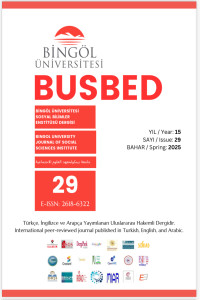TOPLU KONUTLARIN KENT KİMLİĞİ ÜZERİNDEKİ ETKİSİ: DİYARBAKIR ÖRNEĞİ
THE IMPACT OF MASS HOUSING ON URBAN IDENTITY: CASE OF DIYARBAKIR
Author(s): Ayça TARHAN, Canan KoçakSubject(s): Architecture, Rural and urban sociology, Sociology of Culture
Published by: Bingöl Üniversitesi Sosyal Bilimler Enstitüsü
Keywords: Social Housing; Traditional Housing; Local Architecture;
Summary/Abstract: Urban identity, defined as the features and elements that differentiate a city from other cities, has begun to show similar characteristics in almost every city today. With the industrial revolution, cities began to grow uncontrollably, and unplanned urbanization and globalization trends were effective in cities losing their identities. Unlike the traditional texture, similar practices in almost every city have changed the city identity and silhouette. Among the criticisms made in Türkiye are the ideas that the projects implemented by the Mass Housing Administration, which plays an active role in mass housing production, have similar characteristics and are implemented without taking into account the local characteristics of the city. In the study, the question "Do mass housing practices reflect urban identity?" was sought in the Diyarbakır sample. Within the scope of the study, Şilbe mass housing in Yenişehir, Çölgüzeli and Maliye mass housing in Kayapınar district in Diyarbakır were taken into consideration and suggestions were developed by evaluating their suitability for urban identity. The examined mass housing areas were compared in terms of "floor plan, floor height, material, facade features, window sizes, doors, balconies, arches and iwans, colors, garden features and street views" to reveal whether they were similar to the traditional housing texture. It has been observed that Şilbe and Çölgüzeli mass housings are not compatible with the urban identity. Traces of traditional texture were tried to be reflected with the colors and facade decorations used in Maliye mass housing. Therefore, Şilbe and Çölgüzeli mass housing areas are classified as applications of “Standardization Away from Identity”, while Maliye Housing is classified as applications of “Integration of Traditional and Modern Elements”. In this context, it is thought that designs that utilize the advantages of Diyarbakır’s traditional texture and synthesize with elements of modernity and today’s technology will make a positive contribution to the city’s identity. In order to protect the urban identity, while the requirements of the economy are met in planning studies, the suitability of ecological, social, cultural and aesthetic dimensions to the urban identity should be included.
Journal: Bingöl Üniversitesi Sosyal Bilimler Enstitüsü Dergisi (BUSBED)
- Issue Year: 15/2025
- Issue No: 29
- Page Range: 64-83
- Page Count: 20
- Language: Turkish

